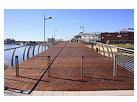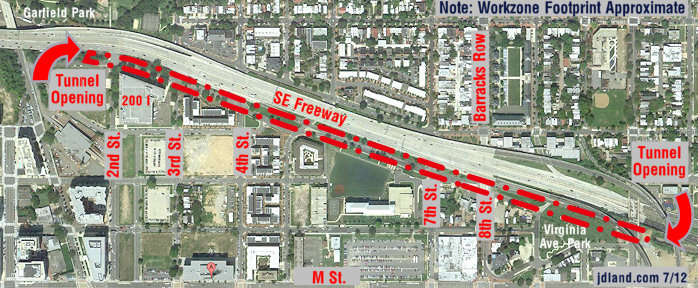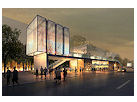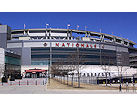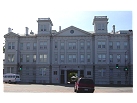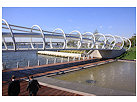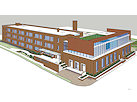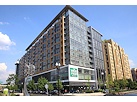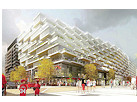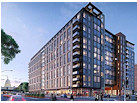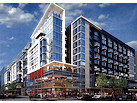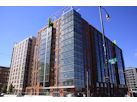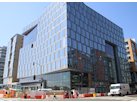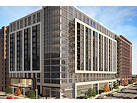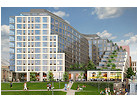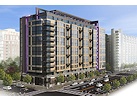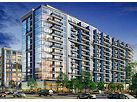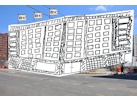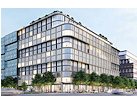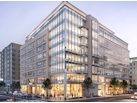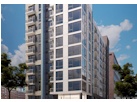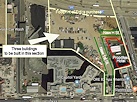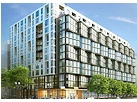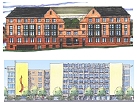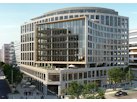|
| ||||||||||||||||||||
Dad's Memories of Capitol Hill,1959-1969
- Full Neighborhood Development MapThere's a lot more than just the projects listed here. See the complete map of completed, underway, and proposed projects all across the neighborhood.
- What's New This YearA quick look at what's arrived or been announced since the end of the 2018 baseball season.
- Food Options, Now and Coming SoonThere's now plenty of food options in the neighborhood. Click to see what's here, and what's coming.
- Anacostia RiverwalkA bridge between Teague and Yards Parks is part of the planned 20-mile Anacostia Riverwalk multi-use trail along the east and west banks of the Anacostia River.
- Virginia Ave. Tunnel ExpansionConstruction underway in 2015 to expand the 106-year-old tunnel to allow for a second track and double-height cars. Expected completion 2018.
- Rail and Bus Times
Get real time data for the Navy Yard subway, Circulator, Bikeshare, and bus lines, plus additional transit information. - Rail and Bus Times
Get real time data for the Navy Yard subway, Circulator, Bikeshare, and bus lines, plus additional transit information. - Canal ParkThree-block park on the site of the old Washington Canal. Construction begun in spring 2011, opened Nov. 16, 2012.
- Nationals Park21-acre site, 41,000-seat ballpark, construction begun May 2006, Opening Day March 30, 2008.
- Washington Navy YardHeadquarters of the Naval District Washington, established in 1799.
- Yards Park5.5-acre park on the banks of the Anacostia. First phase completed September 2010.
- Van Ness Elementary SchoolDC Public School, closed in 2006, but reopening in stages beginning in 2015.
- Agora/Whole Foods336-unit apartment building at 800 New Jersey Ave., SE. Construction begun June 2014, move-ins underway early 2018. Whole Foods expected to open in late 2018.
- New Douglass BridgeConstruction underway in early 2018 on the replacement for the current South Capitol Street Bridge. Completion expected in 2021.
- 1221 Van290-unit residential building with 26,000 sf retail. Underway late 2015, completed early 2018.
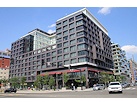
- NAB HQ/AvidianNew headquarters for National Association of Broadcasters, along with a 163-unit condo building. Construction underway early 2017.
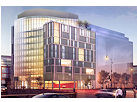
- Yards/Parcel O Residential ProjectsThe Bower, a 138-unit condo building by PN Hoffman, and The Guild, a 190-unit rental building by Forest City on the southeast corner of 4th and Tingey. Underway fall 2016, delivery 2018.
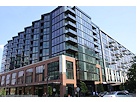
- New DC Water HQA wrap-around six-story addition to the existing O Street Pumping Station. Construction underway in 2016, with completion in 2018.
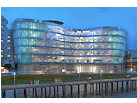
- The Harlow/Square 769N AptsMixed-income rental building with 176 units, including 36 public housing units. Underway early 2017, delivery 2019.
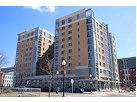
- West Half Residential420-unit project with 65,000 sf retail. Construction underway spring 2017.
- Novel South Capitol/2 I St.530ish-unit apartment building in two phases, on old McDonald's site. Construction underway early 2017, completed summer 2019.
- 1250 Half/Envy310 rental units at 1250, 123 condos at Envy, 60,000 square feet of retail. Underway spring 2017.
- Parc Riverside Phase II314ish-unit residential building at 1010 Half St., SE, by Toll Bros. Construction underway summer 2017.
- 99 M StreetA 224,000-square-foot office building by Skanska for the corner of 1st and M. Underway fall 2015, substantially complete summer 2018. Circa and an unnamed sibling restaurant announced tenants.
- The Garrett375-unit rental building at 2nd and I with 13,000 sq ft retail. Construction underway late fall 2017.
- Yards/The Estate Apts. and Thompson Hotel270-unit rental building and 227-room Thompson Hotel, with 20,000 sq ft retail total. Construction underway fall 2017.
- Meridian on First275-unit residential building, by Paradigm. Construction underway early 2018.
- The Maren/71 Potomac264-unit residential building with 12,500 sq ft retail, underway spring 2018. Phase 2 of RiverFront on the Anacostia development.
- DC Crossing/Square 696Block bought in 2016 by Tishman Speyer, with plans for 800 apartment units and 44,000 square feet of retail in two phases. Digging underway April 2018.
- One Hill South Phase 2300ish-unit unnamed sibling building at South Capitol and I. Work underway summer 2018.
- New DDOT HQ/250 MNew headquarters for the District Department of Transportation. Underway early 2019.
- 37 L Street Condos11-story, 74-unit condo building west of Half St. Underway early 2019.
- CSX East Residential/Hotel225ish-unit AC Marriott and two residential buildings planned. Digging underway late summer 2019.
- 1000 South Capitol Residential224-unit apartment building by Lerner. Underway fall 2019.
- Capper Seniors 2.0Reconstruction of the 160-unit building for low-income seniors that was destroyed by fire in 2018.
- Chemonics HQNew 285,000-sq-ft office building with 14,000 sq ft of retail. Expected delivery 2021.
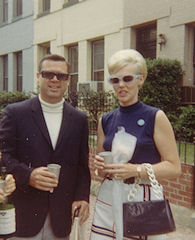
Mom and Dad at 127 E St., SE, Preakness Day 1968. |
Even though Capitol Hill is technically outside of the strict JDLand.com coverage area, in 2011 I asked my father to take some time to write up his memories of the 10 years he and my family lived on the south side of Capitol Hill. After growing up in Detroit and Ocala, Florida, Dad came to Washington in 1959 to work on the Hill, where he met my mother, who also arrived in 1959, from Sheridan, Wyoming. They married in 1962, first living in an apartment at 425 New Jersey Ave., SE, then moving to the basement of 109 C St., SE, and finally buying 127 E St., SE, in 1964. In 1969 Dad went to work for Ford Motor Co., which sent us to Chicago and then Detroit for a few years; we arrived back in the DC area in 1977. Dad currently lives in Silver Spring; my mother died in 2013.
I asked him to do this because I wanted to have his reminiscences of life on Capitol Hill during the 1960s, and I figured that maybe a few readers might find it all of interest as well.
Dad arrives on Capitol Hill, 1959
(posted Jan. 9, 2011)
When I came to Capitol Hill in the spring of 1959, I shared an apartment with my brother Dick in the 400 block of New Jersey Ave., SE. It was a little over a block to the House Office Buildings where we worked, and just another block to the Capitol itself. We had the first floor in a three-story row house. The basement apartment had its own entrance, but the upstairs apartment where a congressman from Texas resided used the same entrance as we did, with a sliding door to enter our apartment and access the stairs up to his.
Many of the row houses in close proximity to the Capitol had been converted into apartments like ours, but very few had been renovated to any great degree. In the summer of '59 we did not have air conditioning or a shower; we were paying $100 a month and after that sweltering summer our landlord wanted to raise the rent. We informed him that we would be more than willing to have our rent increased - if he would install a window air conditioner and a shower, otherwise we would be looking for another place to stay. Fortunately we reached an accommodation with him.
In addition to apartment conversions some of the area houses had been partially converted to business use. On our side of the 400 block of New Jersey one house was the residence and office of a non-profit organization and down the street a few doors from us was Sid Yudain--the founder, publisher and editor of Roll Call, "The Newspaper of Capitol Hill", who had set up his first office in the basement to publish his growing weekly newspaper. Prior to this office, believe it or not, Sid edited and published Roll Call for the first couple of years of its existence out of the office of the congressman he worked for. Finally, down near the corner of New Jersey and E streets, SE, was the convenient Lee Laundry, also located in the row house basement with the Lee family living upstairs.
Change started to come quickly though. Across the street from our apartment one of the stand-alone houses was richly restored and sold to Senator Clair Engle of California for the princely sum of $50,000, which we thought should have bought a mansion.
Our social life revolved mostly around close-in Capitol Hill. There were a few outliers but mainly we hung out in a couple-of-block area on both sides of the Capitol. "Ptomaine Row" as we called it was the 100 block of Pennsylvania Ave., SE (now the location of the Madison Annex of the Library of Congress). Here was our "Main Street" with a few restaurants and bars, a barbershop, a liquor store (Nat Gandel's), a drugstore, and a book and news store (the Trover Shop). Mike Palm's was our favorite drinking and eating spot. In the 200 block there were a few more stores, including a men's shop, a bank, and near the end of the block, Sherrill's Restaurant and Bakery, which opened in 1922 and finally closed its doors in 2000. (Some of the restaurants and bars in the 100 block, including Mike Palm's, moved down to this block when their block gave way to the Madison Annex.)
Our main transportation to downtown DC was the trolley or streetcars or the buses that began to replace them. 1959 was the last year the streetcars ran on Route 30 to Friendship Heights and it was fully replaced by the Route 30 bus in 1960. (The tracks remained for almost another two decades up Capitol Hill on Independence Ave.) As an example of how parochial I was, it was not until we returned to the Washington area in 1977 and bought a home in Chevy Chase that I finally found out where the end of the Route 30 bus line, Friendship Heights, really was. We previously had never made it past Georgetown on the streetcar or bus.
Dad Remembers the Early 1960s, Part 1
(posted Jan. 14, 2011)
Capitol Hill really began to change in the early '60s. And what better kickoff could there have been for the new decade than Sen. John F. Kennedy announcing his candidacy for president on Jan. 2, 1960, in the Senate Caucus Room, where I happened to be among those in the cheering audience. With Senate Majority Leader Lyndon Johnson and Sen. Stuart Symington also running for the Democratic nomination that year, and former senator and then-Vice President Richard Nixon being the Republican candidate, the Hill took on a commanding importance as the sleepy years of the Eisenhower era came to an end.
The excitement in the halls of Congress carried into the neighborhood, especially on the Senate side. In late 1960, The Monocle opened its doors at 109 D St. NE. The Valanos family ran the popular eatery and still does today. It originally was less than half the size it is now, and murals of JFK and Nixon adorned the walls. The best and most expensive dish was a top sirloin, which I think sold for $4.95 for the complete dinner in '60-'61. It was a cozy, convenient courting place for those of us who were in that stage of our lives.
Less than a block from the Monocle and just across the street from the New Senate Office Building (opened in 1958, and now the Dirksen Building) was the Carroll Arms Hotel. In 1958 a new owner had renovated it, and in 1959 he hired a young piano player by the name of Mark Russell, who quickly took in the tempo of his surroundings and launched his 50-year career as one of the country's foremost political comedians.
I remember several cold winter evenings when I would want to sit at Mark's piano bar and banter with him, so I would leave my apartment on the House side and walk the one block to the New House Office Building (now the Longworth Building), using the entrance at New Jersey Avenue and C Street SE and heading to the basement, where I would then walk to the tunnel to the Capitol, through the basement of the Capitol and on to the tunnel to the Senate office buildings, where I would emerge at First and C NE and cross the street to the Carroll Arms.
On my return trip, many times after midnight, I would reverse my walk, and for those who now know only a barricaded and security-minded Washington, perhaps the most amazing thing was that my journeys would usually go unnoticed. At the time, Capitol Hill "guard" jobs -- they weren't official police officers until later -- were usually patronage positions held by male students going to college or law school (one was Harry Reid, now Senate majority leader), and in the late evenings they would be studying their books at their guard desks, in some cases nodding off for a few minutes so they would be fresh for their morning classes, and would not give me more than a glance, if that, as I passed by.
Perhaps nothing better reflected the solitude of these subterranean sojourns than my habit in the basement corridor. At the time there were naked light bulbs hanging from the ceiling every several yards, low enough that I could gently slap them as I went by. When I reached the end of the corridor I would turn and see a couple of dozen of them swinging in crazy arcs of light, making me think perhaps I had imbibed more than I realized.
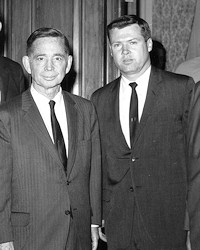
Early 1960s Dad with Carl Albert, who in a few years would be Speaker of the House. |
Beyond the Rayburn Building construction site, if you went farther south and west across Canal and South Capitol streets, there was almost nothing until you got to the Southwest waterfront. Only a few buildings survived one of the earliest "urban renewal" projects in the country, which tore down about 90 percent of the homes and businesses in Southwest. A few remained temporarily, such as Harrigan's bar and grill, which was not far from Hogate's, and where we would go to drink beer and have sandwiches on Friday evenings or the weekend.
The was another Irish restaurant, Riordan's, that was left standing all alone for a year or two in the leveled area, a favorite place for corned beef and cabbage. I'd like to be able to say exactly where it was in Southwest, but there were so few reference points still standing, except on the waterfront. I can't even venture a guess these days.
Meanwhile, the gentrification of the Hill continued radiating out from the Capitol. There were more restored houses, though they were still few and far between as you got farther from the Capitol. Folks talked about Capitol Hill becoming the next Georgetown, but it was, and continued to be, a long way from that.
A couple of my friends on the Hill had bicycles, and when my brother moved from our apartment and, more importantly, took his car with him, I bought a bike from the cycle shop in the 600 block of Pennsylvania Avenue SE (I think it was Capitol Hill Bikes, which eventually moved to Barracks Row). It was a three-speed Raleigh, and although I could have used it more, it did come in handy at times. (On the day I got married in 1962, I rode it down to and around Hains Point at 5:30 a.m. to calm some wedding-day jitters.)
Fifty years ago this month, on January 20, 1961, John F. Kennedy's Inauguration ushered in the dawn of a new day not only for Capitol Hill but for the city and the country as well. Of course, the eight-inch snowstorm and the cold that accompanied it caused major logistical problems (things haven't changed!), but the military got the Capitol and the parade route cleared. It didn't bother me, though, as I had only to walk two blocks up New Jersey Avenue (inaugural ceremonies were on the east side of the Capitol then). But I did have to brush the snow off my reserved seat -- I wasn't in the dignitaries section.
The rest of Washington was still snowed in. Many had abandoned their cars on main and side streets, inhibiting the city's attempt to clear the roads, and trying to navigate in the midst of the inauguration only added to the horrible congestion. It was so bad I gave away to some tourists on Pennsylvania Avenue four tickets to one of the inaugural balls that evening because we didn't see how we could possibly get there in formal wear and get back to the Hill.
We did make the most of the situation, however. A friend bought a case of Budweiser at Nat Gandel's and buried it in a snow bank outside the Cannon House Office Building while he went in to pick up his wife and walk her home, then reburied it outside of Mike Palm's restaurant when they decided to join us for an inaugural cocktail, since we wouldn't be going to the Ball.
Dad Remembers the Early 1960s, Part II
(posted Jan. 21, 2011)
By 1961 I had been living on the Hill for two years and although my work and social life continued to revolve mostly around the Capitol and the immediate environs, I had slowly began to explore beyond the narrow boundaries of close-in Capitol Hill.
Candidly, there wasn't much directly south of my apartment on New Jersey Avenue, SE. I remember only a couple of time going farther than the Capitol Power Plant, which was in the next block, and crossing the bridge over Virginia Avenue and the train tracks into what is known as Near Southeast. It was definitely on the "other side of the tracks" then. As I recall, there were a few shacks and a couple of auto repair-type businesses and vacant lots but that's about the extent of my memory of the area, as we seldom went there even though it was only a couple of blocks away.
On the other hand, Pennsylvania Avenue, SE was a thoroughfare we used regularly, and not only the first few blocks in Southeast, but all the way to and beyond Anacostia. We shopped at Sears, which was off Pennsylvania Avenue on Alabama Avenue, SE in Anacostia, and I started playing tennis on tennis courts that were near Pennsylvania Avenue in a park across the Anacostia River. (Believe it or not, there were also tennis courts, clay ones at that, on Pennsylvania Avenue NW, just a few blocks down from the Capitol, where the East Wing of the National Gallery of Art is now, I believe.)
Another favorite trip out Pennsylvania Avenue, SE was for periodic Sunday dinners at the Oakland Inn, which was across the District line in Maryland on Alabama Avenue. They served the best Southern fried chicken, family style, and for a group of us young guys who didn't get many home cooked meals, it was something we looked forward to and the price was right. It stayed a favorite place even after marriage and kids during the decade we were on the Hill. It eventually became quite popular with Hill folks and many affectionately called it "The Chicken Shack."
Out East Capitol Street they were building DC Stadium (now RFK Stadium), and it opened in the Fall of 1961. A friend of mine and I rode our bikes out to one of the first Redskins' games in the new ballpark. (The Skins were even worse then than under Dan Snyder now!) It was a quick bike trip and we didn't have to pay to park like everyone else, locking our bikes to a lamppost, plus we escaped the traffic jam to and from the Hill. We shook our heads that no one else seemed to have the same idea.
Before DC Stadium, some of us would go to see the Senators play baseball in old Griffith Stadium at Florida and Georgia avenues, NW, and enjoy sitting in the "Beer Garden" in the Left Field stands - even being so gauche at times as to join others in that seating area in removing our shirts and catch a few rays of sunshine. In fact, I visited Griffith Stadium more than I have FedEx Field and I expect that record will stand.
Surprisingly, the sport which caused me to travel the most around the DC area was bowling. The Congressional Secretaries Club had a bowling league and we started bowling at Rinaldi's Bowling Alley in Alexandria off of US 1. It seems hard to imagine these days, but there was another huge bowling alley, with 80 lanes, built where Pentagon City is now, and which at that time was vacant lots and a few warehouses, and we bowled there for a couple of seasons. (I tried to confirm the exact dates of construction and removal of this giant bowling alley via Google and Wikipedia but can find no record of it. [Note from JD: Some hunting in the Post archives by my staff researcher reveals that the "Pentagon City Sports Center" opened in late 1959 and closed on Jan. 14, 1965.])
We then took our league to Silver Hill Bowling Alley on Branch Avenue off Suitland Parkway in Maryland. Strictly from a young, single guy's point of view, I would have traveled any road, bowled in any state, paid any price, to be part of this league. Because Congressional offices in those days were composed mainly of female secretaries - hence, the Congressional Secretaries Club (later it became the Congressional Staff Club) - there were four females and one male on each bowling team when we started out.
(Historical note: As late as the 1960s, the official Congressional Directory listed the top person for each Congressman as "Secretary" going back to when Representatives had only one secretary, although the top staffer by then was called an Administrative Assistant and became that officially before 1970. Still, the majority of the congressional offices were headed by women during the early '60s. Now, you have Chiefs of Staff and the staffs of Congressmen are two to three times as large as they were then.)
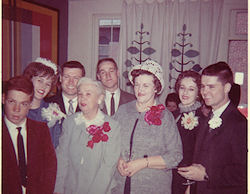
Mom and Dad (2nd and 3rd from left) at their wedding reception on Library Court, SE, with their mothers and three of Dad's brothers. |
We were married in the Spring of 1962. Shirley had been living at the Hill House in the 100 block of D Street SE, and we walked most of her belongings over to my apartment at 425 New Jersey, less than three blocks away. Since my place had been a bachelor's pad for three years and very convenient to Capitol Hill offices, I had to collect keys from many male friends who were use to making it a second home for days, or nights, at a time.
A few months later we moved to a small basement apartment at 109 C Street SE. Here we were even closer to our offices in the Cannon House Office Building which was less than one-half a block away. In fact, it was closer to come home for lunch than to go to the House cafeteria which was, and still is, located in the basement of the Longworth House Office Building.
|
Playing touch football at Second and Pennsylvania, SE. (See another home movie showing the park) |
Across the street from our apartment was the Capitol Hill Club, the club for Congressional Republicans, and a block away in the Congressional Hotel (then at New Jersey and C and now a parking lot), was the National Democratic Club. The Capitol Hill Club and the other buildings and row houses in this whole block across from us were shortly torn down to make room for the Madison Annex of the Library of Congress. Like many government projects, however, the block remained vacant for a couple of years before construction actually started and we use to play pick-up touch football games there on Saturday mornings.
We remained at 109 C Street for about one and a half years and perhaps the most poignant memory of living there was Friday, November 22, 1963. We were home for lunch when a news bulletin came over the radio announcing that President John F. Kennedy had been shot in Dallas.
I rushed over to the Cannon building and in through the entrance nearest our apartment. One of the offices right inside that entrance had an old-fashioned ticker tape. Those were the days when the news first went out "on the wire" and a few of us who were gathered there ripped and read the bulletins as they came across the tape usually before they were announced on radio and TV.
November 22nd was a Friday and the whole weekend was surreal. Those who have been following the recent extended coverage of the shooting of Congresswoman Giffords in Arizona can imagine if that tragedy was increased at least ten-fold. A charismatic President in the prime of his life, with a beautiful wife, and two adorable young children, was assassinated. Nothing like this had happened in the United States for over half a century.
The whole nation in their grief was glued to their TV that weekend and through the State funeral on Monday, November 25. We were watching when Jack Ruby shot Lee Harvey Oswald live on TV. On Sunday, the President's coffin was carried on a horse-drawn cassion up Pennsylvania Avenue from the White House to the Capitol to lie in state. Throughout that day and night, hundreds of thousands lined up to view the casket and the line stretched out the Rotunda doors of the Capitol and down the steps, reaching far down East Capitol Street.
We wanted to pay our respects to President Kennedy lying in state but Shirley was almost nine months pregnant with our son, Jamie, who was to be born nine days later. I walked over to the Capitol to see how long we would have to wait in line and was told it would be at least two to three hours. It was a cold, late November day and we decided it might be too much so we returned to the TV to watch what was going on almost right outside our door.
The death of President Kennedy was particularly devastating to us as we were strong supporters of him and his administration. We had been fortunate to be friends with his personal secretary, Evelyn Lincoln, and her husband Abe, and knew many people who had worked on the Hill with us and had joined the Kennedy Administration.
Shirley and I had been privileged to be invited to the White House by Evelyn on a day President Kennedy was out of town, and she was showing us the the Oval Office when she got a call from the President and went back to her desk to take it, leaving us alone in the President's office for several minutes while she was on the phone. We were somewhat petrified that a top aide would find us there unescorted, or the Secret Service would pop out of nowhere and cart us away.
Life slowly returned to normal on Capitol Hill, although there never seemed to be the same spark after JFK was assassinated. Meanwhile, my Congressman won a coveted seat on the House Appropriations Committee and served on the District of Columbia Appropriations Subcommittee. Those were days when DC was run by appointed DC Commissioners, but Congress, especially the House Committee on the District of Columbia, really pulled the strings.
Walter Tobriner, President of the DC Board of Commissioners at the time, appreciated our attempts to be helpful to the city and rewarded our office by getting us put on the Commandant's list for the Friday evening parade at the Marine Corps Barracks at 8th & I SE. This was and, I understand still is, quite an impressive display of military precision by the Marine Drum and Bugle Corps, the Silent Drill Platoon and ending with the Presenting of the Colors. Many a Friday evening from late Spring throughout the Summer we brought constituents and friends to to the Marine Barracks for this superb presentation.
However, in the early sixties before there was even a Southwest freeway, I have to admit that the Marine Barracks area reminded me of an outpost - sort of a Fort Laramie on the Oregon Trail.
Dad Remembers: Settling in at 127 E St., SE, 1964-1966
(posted Feb. 11, 2011)
After our son was born in December 1963, it didn't take us long to figure out that our tiny basement apartment at 109 C St., SE had instantly become infinitely smaller. Sharing the small bedroom with the baby crib and baby gave us a true sense of (lack of) space.
|
Moving into 127 E, SE. (Dad is manning the camera) |
Right after bringing in the 1964 New Year, we started looking again, and this time to buy. And rather than confining our search to the immediate area surrounding the House Office Buildings and the Capitol where our apartments had been, we branched out a few blocks beyond. Not many, though, as we found our first home in the 100 block of E Street SE. It was a two-story, 17-foot wide, 40-foot long, basically restored townhouse, which we bought for $26,000 in February 1964.
(Precisely the month we were busy buying and financing our new home, the Beatles were holding their first concert in the U.S., at the Washington Coliseum on Capitol Hillm less than one mile from us. Tickets to the show ranged from $2 to $4, and there were 8,092 fans at the concert, which was opened by The Chiffons and Tommy Roe. The Beatles opened with "Roll Over Beethoven." I had seen Louis Armstrong there when it was the Uline Arena but we did miss history being made, much to the chagrin, I'm sure, of my daughter, JD, a lifelong fervent Beatles fan.)
The $26,000 we paid for 127 E St. SE., may sound inordinately inexpensive for a near-in Capitol Hill townhouse these days, but according to Perpetual Building Association and the few other banks who would consider financing on Capitol Hill at that time, it was overpriced. Perpetual offered us a $16,000 mortgage, with a minimum of $3,000 down, necessitating a $7,000 2nd Trust as they then called it. Fortunately, a Capitol Hill bank saw enough investment opportunity in the area to advance us that amount. They also gave us a little passbook, which we would either take up to the bank on Pennsylvania Ave SE or mail it in, and they would record in ink how much went to principal and how much to interest with each payment.

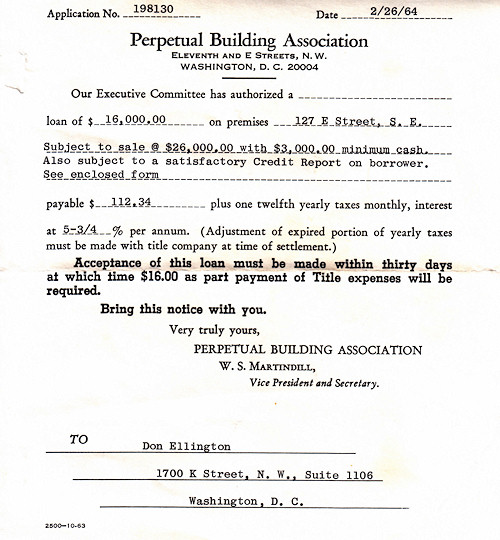
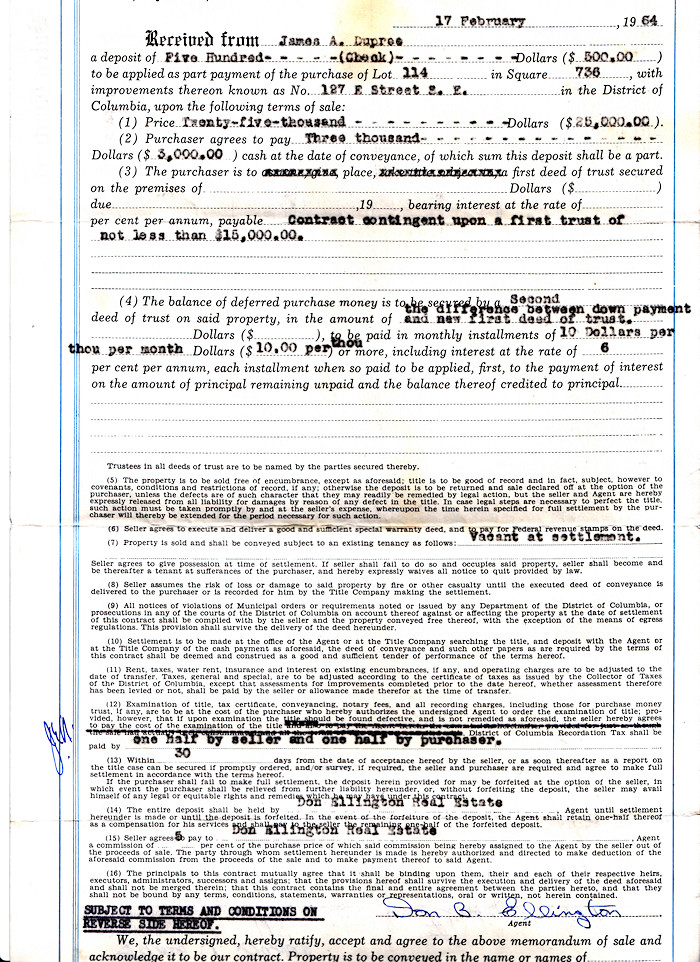
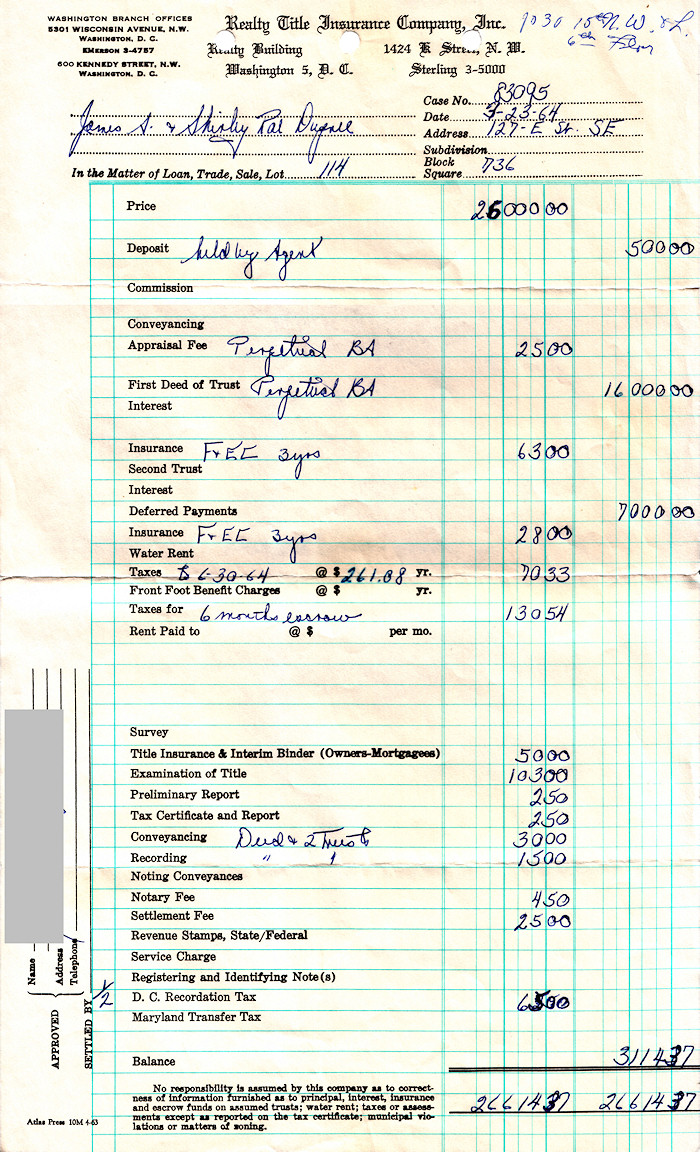
Purchase documents for 127 E St., SE, from 1964. Click each to enlarge.
In reviewing my records of our first home purchase (which you can see above), one thing struck me and that was the relative simplicity of the transaction. In 1964 the length of a home sales contract was one legal-size page; the Settlement was also one legal-size page. In our most recent home purchase, the contract and settlement papers were about one-half inch thick for each.
Buying a Capitol Hill home changed our outlook quite a bit. Prior to purchasing our place, the Capitol Hill area was considered more for its convenience to our work in Congress than as a residential community. Now, we were not only tax-paying property owners but, in the words of Hechinger's, we were Harry Homeowners. And to a great extent Hechinger's and Sears replaced the Monacle and Mike Palm's as primary places to spend our money.
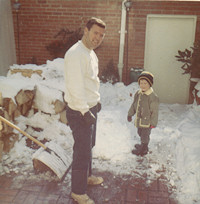
Dad and Jamie in the backyard, with the new garage, after the Blizzard of January '66. |
Like most new homeowners, almost all of our spending indeed went into our new home, first on the inside and then the outside. By the end of our first year, we had plans to add a garage. Of course, navigating the DC bureaucracy to get permit approval for the garage was a nightmare in those days, and it took a little political pressure from the Hill to move things along.
When our plans finally were about to be approved, one of the old-time bureaucrats in the building permits office asked me if I hadn't forgotten to add one thing to the garage. When I inquired as to what he was thinking of, his response was, "barbed wire," indicating that Capitol Hill was still not looked upon as a "safe" investment among some people, to say the least.
Between the planned garage and the house we had a little patio, and I remember buying a small Magnolia tree from Hechinger's for $7.50 to plant in our south-facing patio, which was in desperate need of some shade. Forty-some years later, if you drive through the alley behind 127 E (or peek in from on high via Google Maps), you can see a giant Magnolia tree, taller by 10 or 20 feet than the townhouse itself and no doubt now dominating much of the patio where I planted it.
|
Riding on the 100 block of E, SE, in 1965, with Jamie riding shotgun. Safety concerns were clearly paramount. |
E Street SE in the early to mid-'60s was somewhat of a thoroughfare, because the Southwest Freeway east of South Capitol Street hadn't been constructed yet. When freeway construction did start shortly after we arrived, cement trucks would rumble up and down E Street all day, beginning usually before dawn.
Because of the traffic and the substantial size of most of the houses in the 100 block of E, very few had been or were restored during the six years we lived there. On the other hand, behind us on Duddington Place, which runs between 1st and 2nd streets, almost all of the small, cozy townhouses on the block had been or were being restored and sold. One block further south, F Street SE, facing Garfield Park, was also active in restoration during the '60s, as was South Carolina Ave SE adjacent to the park.
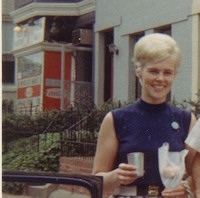
A photo of Mom, showing a glimpse of the old Weisfeld's Market at 131 E. |
One convenience we did enjoy on E Street was Weisfeld's Market, which was located in one of the big row houses in the middle of the 100 block, only two doors from us. It was so close that my wife Shirley couldn't help but shop there. She especially liked that she wouldn't even have to bring any money with her, as Mrs. Weisfeld would just write on the back of a brown paper grocery bag the price of each item she bought and then total it up at the end of the month and tell us how much we owed.
A couple of prominent new places opened up on Capitol Hill at this time. A warehouse on Ivy Street SE right off of New Jersey Avenue, SE was converted into "The Rotunda," a dining, drinking and dancing hangout for lobbyists, Congressmen and Capitol Hill aides. It became infamous in the 1970's when the Iranian-born maitre d' was murdered, with authorities suspecting it was drug-related. The National Democratic Club took over the location when The Rotunda went out of business and is still there, and the Democratic National Committee bought the land next door and built their present headquarters. Also, Mr. Henry's at 6th and Pennsylvania, SE opened in 1965, and help extend the boundaries of where Hill people felt comfortable going.
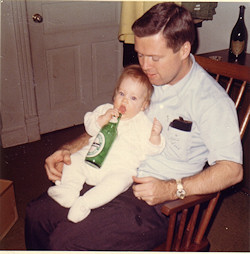
Dad, in his Kennedy rocking chair, getting his baby daughter started off on the right foot. |
Also, in January 1965, my wife went back to work for a new Congressman from Syracuse. We were fortunate to have a maid/baby sitter who lived only a couple of blocks from us and who became full time as Shirley and I resumed our daily walk to and from the House Office Buildings.
In August, 1966, our daughter Jacqueline (better known as JD of JDLand) was born. When we brought her home from Washington Hospital Center, her first house was only three blocks from where she and her husband have resided for the past 15 years.
Home movies of E Street after the Blizzard of 1966. (Second half of the footage, at Marion Park, is from 1967.)
Dad Remembers: The Late 60s
(posted Feb. 25, 2011)
The late '60s on Capitol Hill were busy years for us. After Jacqueline was born, my wife, Shirley, went back to work for the Congressman she had been working for and with two very young children and both of us working and very active on the Hill it was quite a balancing act. Being within walking distance of home and the kids helped a lot, as did having household help and babysitters who were convenient and dependable.
I can recall one especially busy two-week period at the start of a new Congress: Not only were there the usual start-of-the-session parties and receptions when a new Congress is convening, but my Congressman invited 50 of his best friends and supporters to Washington for his swearing-in and an extended visit to the Nation's Capitol. I was in charge of making arrangements for their stay and entertaining them for most of the week they were here. I put them up at the new Skyline Inn at South Capitol and I streets, SW, and I remember having a well-used hospitality suite in Room 222, which our Chicago-types appropriately nicknamed "The Three Deuces." In a letter to a friend explaining why I hadn't written in a while, I noted we had babysitters twelve out of thirteen nights during this period.
We became friends with the Skyline Inn's manager and his wife, who had a son approximately the same age and with the same name as ours, and we were offered a family membership for $25 to use the Skyline Inn pool for the summer. We were quick to accept and made good use of the pool for the last few summers we were on the Hill - and it was there our son and daughter learned to swim. It was seldom crowded and we would enjoy swimming and poolside cocktails with the manager and his wife during many hot Washington summer late afternoons and weekends. Shirley and I also took advantage of the tennis courts that had concurrently been built across from the Skyline Inn on I Street.
|
Swimming at Skyline Inn, 1969. |
Playing tennis at South Capitol & I, 1969. |
Southwest DC was by then well on its way to being rebuilt after 90 percent of it had been torn down in the '50s. Arena Stage, which had opened at its present location in the early '60s, was the first regional theater to transfer a production to Broadway when in 1967 The Great White Hope went on to Broadway with its original cast, including James Earl Jones and Jane Alexander.
When Congress was not in session we would enjoy leisurely Friday lunches and "birdbath martinis" at The Market Inn at 200 E St. SE, within walking distance of the House Office Buildings. And of course the Southwest waterfront continued to develop. One popular place in the late '60s was The Gangplank Restaurant, which featured dining on the water. I remember going up the gangplank for dinner one evening and a gentleman and his party in front of us were turned away because he was not wearing a tie. He was a young Congressman from Texas by the name of George H.W. Bush, later to be the 41st President of the United States.
Meanwhile, Capitol Hill's restoration also accelerated, moving into what were the outer reaches of Capitol Hill in those days. As more young families such as ours began to make Capitol Hill home, parks such as Garfield and Marion, and schools became focal points of attention.
|
Mom and Jamie at Garfield Park, 1964. (SE Freeway construction visible briefly, along with 225 Virginia/200 I.) |
Jamie and JD at Folger Park, 1968. (You can see the old Brent School, along with the current one, then under construction.) |
Fortuitously, Capitol Hill Day School opened in 1968-69, just as our son, Jamie, reached preschool age, and we enrolled him in the first classes, first at the Lutheran Church of the Reformation on East Capitol Street and then at Christ Church on G Street SE, and he attended CHDS until we left the Hill at the end of 1969.
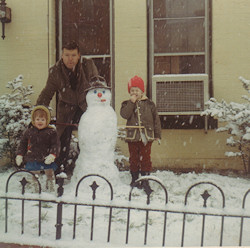
Winter 1967/1968. |
(We had had plans to enroll him in Brent Elementary on 3rd Street SE, which in the mid-'60s had become somewhat racially balanced: Brent was about two-thirds African American, if I remember correctly, until the District School Board changed the school's boundaries. This brought large numbers of children to Brent from the public housing area south of the Southeast Freeway [Capper/Carrollsburg], which changed the school's enrollment to almost 100 percent African American as a result. Like so many parents for so many years in Washington with the means to do so, we then opted to go the private school route.)
Unfortunately for Capitol Hill and all of Washington as well as the country as a whole, nothing in our decade, or perhaps in any decade, could be compared to the riots of April, 1968. My wife and I were coming out of a political dinner at the Washington Hilton late in the evening of April 4, 1968, when we heard that Martin Luther King had been assassinated and that crowds were gathering all over the city. Our car was parked a few blocks away on a side street and out of precaution we took a cab for the couple of blocks to retrieve it. By the time we got home to Capitol Hill, there were numerous reports of disturbances and in fact rioting and looting had already broken out.
Friday morning, there was an uneasiness of what was going to happen next and by midday rioting had resumed and building were being set on fire, and firefighters were being attacked with bottles and rocks and were unable to respond to the spreading fires. We had gone to work and that afternoon we went over to the Capitol to see for ourselves what was being reported on radio and TV.
It was surreal to walk out on the Northwest portico of the U.S. Capitol and see the fires burning in the 7th and 14th Street NW corridors. Looking east, we could see smoke rising from the H Street NE area. There were no fires on Capitol Hill, but almost all of the store fronts were broken into all over Capitol Hill, especially the liquor stores, including one at the corner of D Street and North Carolina Avenue, less than a block from our house.
By this time the military had been called out and the DC National Guard had been federalized. Here's how Wikipedia describes the deteriorating situation:
"Marines mounted machine guns on the steps of the Capitol and Army troops from the 3rd Infantry guarded the White House. At one point, on April 5, rioting reached within two blocks of the White House before rioters retreated. The occupation of Washington was the largest of any American city since the Civil War. Mayor Washington imposed a curfew and banned the sale of alcohol and guns in the city. By the time the city was considered pacified on Sunday, April 8, twelve had been killed (mostly in burning homes), 1,097 injured, and over 6,100 arrested. Additionally, some 1,200 buildings had been burned, including over 900 stores."
What neither Wikipedia nor news outlets at the time reported was that there were also tanks on Capitol Hill, including one outside our door in the 100 block of E Street SE, and one in the 100 block of North Carolina Avenue SE. I was told by a White House source that President Johnson personally had instructed that they be available in case of an assault on the Capitol, but he wanted them out of sight fearing an international black eye for the United States if there were photos of tanks surrounding the Capitol building, protecting it from its own people.
As bad as the situation was, most of us living on Capitol Hill did not feel personally endangered. It was not so much the military and tanks patrolling the streets as it was the realization that the unfortunate areas targeted for attack were the black population's own business and entertainment areas that were looted and burned out. We even heard teenagers across the street loudly yelling to each other what stores they had help loot and what they had been able to carry off.
By the end of the weekend though, the city had been brought under control and on Monday things were normal enough that neighbors were stopping by to say they were planning a "milk" run to the suburbs since District liquor stores would not be opening soon.
The aftermath deepened the racial and economic divide, already wide, in the city and on Capitol Hill. As Wikipedia puts it, the riots "utterly devastated Washington's inner city economy. With the destruction or closing of businesses, thousands of jobs were lost, and insurance rates soared. Made uneasy by the violence, city residents of all races accelerated their departure for suburban areas, depressing property values. Crime in the burned out neighborhoods rose sharply, further discouraging investment."
However, Capitol Hill did not seem to suffer as much as other areas. From what I saw and experienced, I would say there was very little migration to the suburbs, but there was a pause in the growth on Capitol Hill. The burned out H Street NE corridor and Barracks Row--where there was so much looting that many shop owners never reopened--did seem to set boundaries on development on Capitol Hill for several years, just as "The Great Recession" has caused a similar pause in Southeast DC the past couple of years.
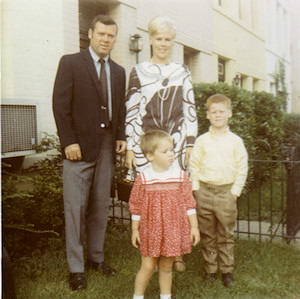
The family in front of 127 E, summer 1969, a few months before we left Capitol Hill for Chicago. |
We left Capitol Hill in November, 1969, not because of any desire to leave the Hill but because of an opportunity to join Ford Motor Company in Chicago as their Regional Civic and Governmental Affairs Manager, representing Ford in several Midwest states. We did not sell 127 E right away, holding onto it until the nice young couple who were renting it prevailed upon us to sell it to them.
When we returned to the Washington DC. area in 1977, we settled in Chevy Chase, MD, mainly because of the public schools. But we were still attached to DC, and not just figuratively, since part of our front yard on Western Avenue was literally within the boundaries of the District. I represented Ford Motor Co. on Capitol Hill until 1993, which gave me and my family the chance to renew our relationships and affection for the Capitol Hill area. Even in retirement, I still am a member of the 116 Club at 2nd and C Streets NE and the Democratic Club on Ivy Street SE and enjoy lunch on the Hill with old Hill friends a couple of times a month.
And of course, with our daughter Jacqueline and her husband Bill residing on South Carolina Avenue SE for nearly 16 years, we have plenty of chances to visit some of our old haunts with them, like the Monacle and Mr. Henry's, where upstairs we remember listening to Roberta Flack perform at the beginning of her career. And having a meal at Molly Malone's on Barracks Row reminds me of when it originally opened in the mid '70s as The Broker restaurant, which I believe was the first upscale restaurant to open on 8th Street SE in the aftermath of the '68 riots. Of course, it took a couple of decades longer for H Street NE to make its comeback.
Along with our son, who will soon celebrate the 30th anniversary of when he first started working on Capitol Hill as a page in the House of Representatives and who has had a cubicle in both the House and Senate Press galleries during two decades as Washington correspondent for Cox Radio, the whole family, starting with Shirley and me in 1959, have been, and will remain, loyal to our Capitol Hill roots.
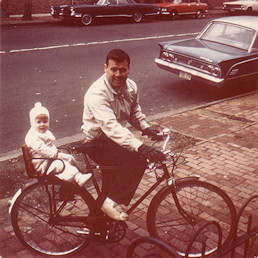
JD and Dad, 1968. |
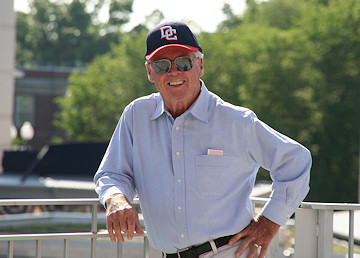
Dad at Nationals Park, 2008. |



